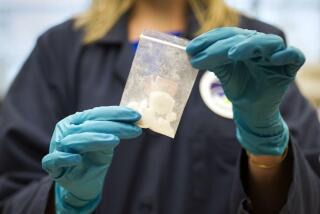Argentina a new hub for meth traffickers
BUENOS AIRES — The three young entrepreneurs met their contacts outside a Wal-Mart here and drove off with them, apparently convinced that they would be celebrating a lucrative new deal.
But authorities believe it was a set-up, linked to Mexican mobsters bent on reshaping the global drug trafficking map.
The three men were handcuffed, forced to kneel in the mud and sprayed with bullets; their bodies were dumped in a ditch.
The execution-style slayings have sent shock waves across Argentina, which has largely been spared the drug violence seen in Colombia and Peru, the world’s top cocaine producers. These killings, authorities say, were related to a more prosaic product: ephedrine, the synthetic stimulant found in cough and cold remedies. Ephedrine is also used in the manufacture of methamphetamine, the highly addictive drug long a scourge in the United States.
Officials suspect that the three men were involved with a relatively new smuggling route called the “ephedrine highway,” the triangulated transport of ephedrine from Asia to Argentina to Mexico, ultimately destined for the booming U.S. meth market.
Mexican traffickers have become the main suppliers of methamphetamine to the United States. But a crackdown in Mexico has squeezed supplies of ephedrine from Asia, leading the gangs to seek their raw material in Argentina, a nation with a robust pharmaceutical industry, relatively few controls and a reputation for corrupt cops and customs inspectors.
The Mexican-Argentine relationship has proved an expedient marriage: abundant product, a compliant host nation and an efficient trafficking network. But the brutal killings have exposed the perils of courting Mexican drug rings.
“When Mexican traffickers arrive they bring in organized crime and violence,” said Special Agent Michael Sanders, a spokesman in Washington for the Drug Enforcement Administration. “That has unfortunately proved to be the case in Argentina.”
--
Expanding networks
Once confined largely to their homeland and U.S. border states, Mexican criminal gangs have vaulted over international frontiers and formed far-flung alliances.
“The Mexican trafficking organizations already have smuggling routes set up throughout South America for moving cocaine,” Sanders said. “So traffickers can use the same routes and techniques to move ephedrine.”
Methamphetamine is a multibillion-dollar industry in the United States, though its use is believed to have leveled off since the 1990s. Last year, federal authorities reported that a red, cherry-flavored methamphetamine, called go-fast, showed up in Central and Northern California, aimed at the youth market
U.S. authorities began to notice last year that street prices were soaring for methamphetamine, acting U.S. Drug Enforcement Administrator Michele Leonhart said at a conference in July in Istanbul, Turkey. Authorities attribute the price increase to heightened enforcement pressures south of the Rio Grande.
The lure of drug profits had for years spurred large-scale importation of ephedrine and related products to Mexico, mostly from Asia. At Washington’s urging, Mexico last year moved to ban most ephedrine imports and moved aggressively against meth labs.
In one high-profile case, Mexican police busted a methamphetamine ring allegedly run by a Shanghai-born Mexican citizen, Zhenli Ye Gon. He is accused of bringing in vast quantities of an ephedrine derivative from China. Mexican police also seized more than $200 million in cash from Ye Gon’s lavish Mexico City residence. The record bust pinched the amphetamine pipeline, authorities said.
As a result, desperate Mexican traffickers turned to Argentina, according to the DEA.
Argentina, like Mexico, is not a manufacturer of ephedrine. But the country’s pharmaceutical sector is a major importer, buying mostly from China and India.
Imports of ephedrine to Argentina recently began to soar -- from 2.9 tons in 2004 to 19.1 tons in 2007, according to government figures.
Police suspect ephedrine, and possibly manufactured methamphetamine, was being smuggled from Argentina to Mexico via at least two methods -- by “mules” on commercial flights, the diluted drugs sometimes placed in wine bottles carried on board; or disguised as sugar or other products in maritime shipping containers. Once converted to methamphetamine in Mexico, the drug is smuggled into the U.S. by individuals and in cars and trucks, just like other illegal substances.
--
Hiring collaborators
But the Mexicans could not do it alone. They needed Argentine partners with links to legitimate pharmacies and drug laboratories, which could legally import ephedrine.
By all accounts, Sebastian Forza, 34, was an ambitious and dexterous deal-maker with ample contacts in the Argentine pharmaceutical world. He left law school to set up a medical supply firm, which appeared to be thriving. He owned no fewer than six cars and a pair of high-powered motorcycles. He lived with his wife and son in a gated community. He was tall, slim, broad-shouldered and an impeccable dresser.
“Baby-faced, with blond hair and blue eyes,” is how his wife, Solange Bellone, described him to the Argentine daily Clarin. “He cared a lot about how he looked.”
There was a dark side, however. Forza was deeply in debt. He was a serial check bouncer. At one point he was investigated for illegal trafficking in prescription drugs. He complained of threats from ex-associates.
And now he’s dead, along with the two partners with whom he met at the Wal-Mart.
A phalanx of investigators is trying to untangle Forza’s possible dealings with the ephedrine trade. One line of inquiry: Whether he was an intermediary in the purchase of failing Argentine drug concerns whose names and import licenses could then be used to order ephedrine from Asia.
Police are also focusing on Forza’s relationship with another Argentine pharmaceutical entrepreneur, Luis Marcelo Tarzia, who is in custody here.
Tarzia, 61, was arrested July 18 along with nine Mexican suspects at a suburban estate that police say was a clandestine methamphetamine lab. The lab, officials say, was a wholly owned subsidiary of Mexican gangs. The Mexican suspects were all reportedly linked to the powerful Sinaloa cartel.
In statements to police, Tarzia has acknowledged knowing Forza but denied any links to the ephedrine commerce. He said he believed the Mexicans were in the leather-curing business.
On Aug. 7, Forza, along with partners Damian Ferron and Leopoldo Bina, met with two men and a woman, as yet unidentified, in a cafe outside the Wal-Mart, police say. The victims apparently believed that a new deal had been struck. They drove off to celebrate.
“They left with the illusion that something was promised to them,” Forza’s widow said on Argentine television. “They were with the wrong people at the wrong time.”
Six days later, their bullet-riddled bodies were found in a ditch along a highway. Forza had been shot seven times. Another victim’s ear had been cut off -- an apparent message, its exact meaning unclear.
Why the three were killed remains a mystery, though police suspect that the drug gang believed Forza had double-crossed them.
A former associate of Forza, Ariel Vilan, later committed suicide, leaping from the balcony of a ninth-floor apartment. A slew of threats had terrorized him, friends said.
Since the triple killings, Argentine investigators have been tracking the murky ephedrine paper trail and searching pharmacies, customs docks and warehouses for leads. Authorities also announced new controls on ephedrine imports.
“Our concern is to limit these chemical substances that can be used for the manufacture of methamphetamine,” Justice Minister Anibal Fernandez said in a TV interview in Buenos Aires.
“If we get rid of this raw material,” he added, “we not only avoid trafficking to Mexico and the United States, but we also avert the possibility that methamphetamine is produced here in the future.”
--
patrick.mcdonnell @latimes.com
Andres D’Alessandro of The Times’ Buenos Aires Bureau contributed to this report.
More to Read
Sign up for Essential California
The most important California stories and recommendations in your inbox every morning.
You may occasionally receive promotional content from the Los Angeles Times.










